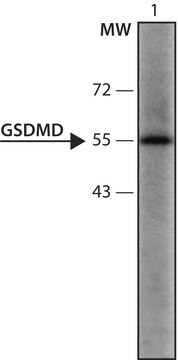MABT398
Anti-CD226/DNAM-1 Antibody, clone LeoA1 (Azide Free)
clone LeoA1, from mouse
Synonym(s):
CD226 antigen, DNAX accessory molecule 1, DNAM-1, CD_antigen=CD226
About This Item
Recommended Products
biological source
mouse
Quality Level
antibody form
purified antibody
antibody product type
primary antibodies
clone
LeoA1, monoclonal
species reactivity
human
technique(s)
activity assay: suitable
flow cytometry: suitable
immunocytochemistry: suitable
immunoprecipitation (IP): suitable
inhibition assay: suitable
western blot: suitable
isotype
IgG1κ
NCBI accession no.
UniProt accession no.
shipped in
dry ice
target post-translational modification
unmodified
Gene Information
human ... CD226(10666)
Related Categories
General description
Specificity
Immunogen
Application
Flow Cytometry Analysis: 1.0 µg of this antibody from a representative lot detected CD226/DNAM-1 in 1X10E6 CD226 transfected CHO cells.
Activity Assay Analysis: A representative lot detected CD226/DNAM-1 which induces platelet aggregation (Scott, J.L., et al. (1989). Journal of Biol. Chem. 264(23):13475-13482).
Competative Binding Assay Analysis: A representative lot detected CD226/DNAM-1 in the binding of this antibody to resting and pharmacologically activated PHA-induced blasts and Jurkat cells (Sherrington, P.D., et al. (1997). Journal of Biol. Chem. 272:21735-21744).
Inhibition Assay Analysis: A representative lot detected CD226/DNAM-1 which inhibited the induction of both CTL andAK cells from their precursors (Burns, G.F., et al. (1985). J. Exp. Med. 161:1063-1078).
Immunoprecipitation Analysis: A representative lot detected CD226/DNAM-1 in MLA-I44 cells (Burns, G.F., et al. (1985). J. Exp. Med. 161:1063-1078).
Immunoprecipitation Analysis: A representative lot detected CD226/DNAM-1 in Jurkat PTA-1 transfectants stimulated with TPA (Ralston, K.J., et al. (2004). Journal of Biol. Chem. 279:33816-33828).
Cell Structure
Adhesion (CAMs)
Quality
Western Blotting Analysis: 0.5 µg/mL of this antibody detected CD226/DNAM-1 in 10 µg of CD226 transfected CHO cell lysate.
Target description
Physical form
Storage and Stability
Handling Recommendations: Upon receipt and prior to removing the cap, centrifuge the vial and gently mix the solution. Aliquot into microcentrifuge tubes and store at -20°C. Avoid repeated freeze/thaw cycles, which may damage IgG and affect product performance.
Other Notes
Disclaimer
Not finding the right product?
Try our Product Selector Tool.
Storage Class
12 - Non Combustible Liquids
wgk_germany
WGK 2
flash_point_f
Not applicable
flash_point_c
Not applicable
Certificates of Analysis (COA)
Search for Certificates of Analysis (COA) by entering the products Lot/Batch Number. Lot and Batch Numbers can be found on a product’s label following the words ‘Lot’ or ‘Batch’.
Already Own This Product?
Find documentation for the products that you have recently purchased in the Document Library.
Our team of scientists has experience in all areas of research including Life Science, Material Science, Chemical Synthesis, Chromatography, Analytical and many others.
Contact Technical Service








